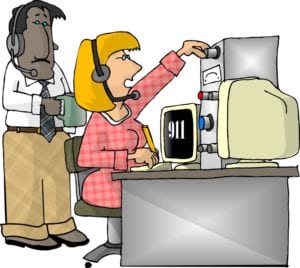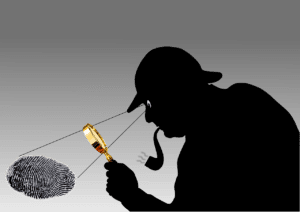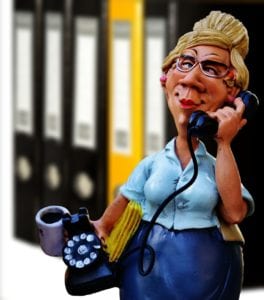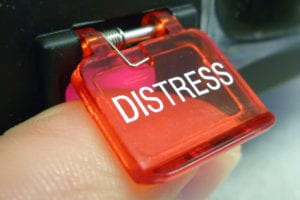 One of the situational awareness best practices discussed during the Fifty Ways to Kill a First Responder program is the role played by the dispatcher during an emergency incident. As I have discussed this many times with first responders throughout the United States I have come to the conclusion that in some jurisdictions the dispatcher role is either ignored or downplayed. This is very unfortunate because a dispatcher’s contribution to incident situational awareness can be significant. Let’s explore how.
One of the situational awareness best practices discussed during the Fifty Ways to Kill a First Responder program is the role played by the dispatcher during an emergency incident. As I have discussed this many times with first responders throughout the United States I have come to the conclusion that in some jurisdictions the dispatcher role is either ignored or downplayed. This is very unfortunate because a dispatcher’s contribution to incident situational awareness can be significant. Let’s explore how.
Call information
 The dispatcher is the first person to gather clues and cues about an emergency. An experienced, well-trained dispatcher is able to gather a lot of high quality, vitally important information that can help first responders form an early understanding of what they will be facing upon arrival at the emergency scene. In some dispatch centers the questions asked of callers are scripted or there may be prompts to help dispatchers gather the essential facts.
The dispatcher is the first person to gather clues and cues about an emergency. An experienced, well-trained dispatcher is able to gather a lot of high quality, vitally important information that can help first responders form an early understanding of what they will be facing upon arrival at the emergency scene. In some dispatch centers the questions asked of callers are scripted or there may be prompts to help dispatchers gather the essential facts.
Callers are often distraught when calling 9-1-1 and the dispatchers have the difficult task of both calming the caller and extracting quality information from them. If you have spent any time as a dispatcher or in a dispatch center during the processing of a critical emergency call you understand this can be a very challenging task. In haste, the callers often abbreviate what they are saying. Some may become agitated and scream at the dispatchers, complicating the ability to understand.
Depending on the type of emergency, location and time of day, a dispatch center can get dozens of calls about an emergency. The massive influx of 9-1-1 calls can be overwhelming depending on the number of dispatchers on duty.
I once recall a dispatcher sharing a story where he was the only one on duty and the 9-1-1 phones starting lighting up for a residential dwelling fire. He was on-duty alone and was doing his best to dispatch the appropriate police, fire and EMS agencies. As he did, the 9-1-1 calls kept coming in. Finally, as the callers would say “There a house on fire…” The dispatcher interrupted and told the caller the fire department was on its way, hung up, and took the next call. The only problem is, there were two house fires and the dispatcher missed receiving the report of the second house fire because he was cutting the callers off short of allowing them to give the address for the fire. Fortunately, the second house fire was discovered by a police officer while responding to the first house fire. Otherwise, the outcome might have been catastrophic.
Call Takers
 Some dispatch centers are staffed with personnel who serve as call takers. Their sole job is the answer the phones, gather the essential information, then pass the information on to the dispatcher who will, in turn, send to appropriate agencies. Sometimes the call information is routed to multiple dispatchers, each dispatching one service provider (e.g., police – fire – EMS).
Some dispatch centers are staffed with personnel who serve as call takers. Their sole job is the answer the phones, gather the essential information, then pass the information on to the dispatcher who will, in turn, send to appropriate agencies. Sometimes the call information is routed to multiple dispatchers, each dispatching one service provider (e.g., police – fire – EMS).
The call taker model, while efficient, can have some inherent challenges. There is always the possibility of multiple call takers receiving multiple 9-1-1 calls about the same incident. If the call takers know that one of their associates is taking an incoming call about an emergency, they may simply confirm the address with the caller and tell them responders are on the way. The problem with this is the quantity and quality of information gathered by each caller can be very different. The first call taker might be able to gather very little information from a distressed caller. A subsequent caller (to another call taker) might offer much more information of higher quality but that caller was cut off.
Dispatch training and priorities
 Some emergency response agencies may operate their own dispatcher center and not share dispatching services with other agencies. Many dispatch centers, however, serve many agencies. Many of those are under the control of police or sheriff departments. Fundamentally, it shouldn’t matter whose control dispatch falls under so long as the quality of service for all agencies served is high. Unfortunately, this is not always the case.
Some emergency response agencies may operate their own dispatcher center and not share dispatching services with other agencies. Many dispatch centers, however, serve many agencies. Many of those are under the control of police or sheriff departments. Fundamentally, it shouldn’t matter whose control dispatch falls under so long as the quality of service for all agencies served is high. Unfortunately, this is not always the case.
In some jurisdictions the priority for dispatcher training and job performance is slanted in the direction of the agency that controls the dispatch center. To some degree this is understandable. The dispatcher is going to give deference to the agency that signs their paycheck. A problem can arise when a dispatch center becomes unresponsive to the needs of other agencies they dispatch for. Dispatching for fire and dispatching for police, for example, are different.
Incident scene communications support
 In a properly staffed, highly functioning communication center a dispatcher would be assigned to handle the radio communications for a critical incident and that would be their sole responsibility. Where this happens – and it does happen for those who have not benefited from this design – the dispatcher serves as a scribe and a second set of ears for the incident commander. This can be a huge asset to a commander. For starters, the dispatcher is in a lower stress environment because they are physically located in a controlled environment that is not dynamically changing (like an emergency scene is).
In a properly staffed, highly functioning communication center a dispatcher would be assigned to handle the radio communications for a critical incident and that would be their sole responsibility. Where this happens – and it does happen for those who have not benefited from this design – the dispatcher serves as a scribe and a second set of ears for the incident commander. This can be a huge asset to a commander. For starters, the dispatcher is in a lower stress environment because they are physically located in a controlled environment that is not dynamically changing (like an emergency scene is).
Dispatchers often wear radio headsets that allow them to filter out extraneous noise so they can concentrate on the radio traffic they are monitoring. A dispatcher can have ready access to resource information like weather and traffic condition reports. If they have access to the Internet they can quickly find answers to questions for the commander.
On several occasions I’ve had incident commanders share with me stories where they were operating at emergency scenes and, for whatever reason, did not hear critical radio traffic. The dispatcher was monitoring the radio and immediately informed the commander of the radio traffic and averted a catastrophe.
ETNs and PAR checks
Two support tasks a dispatcher can perform that can be very helpful to emergency responders are Elapsed Time Notifications (ETNs) and Personnel Accountability Reports (PARs). These tasks can be performed by the commander or a command team member as well. Sometimes those additional personnel are not readily available on an emergency scene. This is where the dispatcher can really help out.

An ETN is an announcement, over the radio, for all operational personnel to hear (which means it might have to be announced multiple times on multiple channels so everyone does hear it) of the time that has elapsed at an emergency. This is critical to the formation and maintenance of situational awareness for two reasons.
First, responders need to form expectations of outcomes. This is one of the steps in the decision making process. One of those expectations is HOW LONG should it take for personnel to complete tasks. An ETN helps a commander keep track of the passage of time and can benchmark the time passage to the process of assignments.
Second, Level 3 Situational Awareness is formed by making accurate predications of future events (beyond company-level performance of tasks). Think of company-level performance of tasks as scenes in a movie. Think of Level 3 Situational Awareness as figuring out how the entire movie is going to end.
In most dynamically changing environments responders have a finite time to complete tasks or the situation may overrun them (e.g., extinguish the fire and get out before the building collapses). The amount of time responders can operate in rapidly changing environments is, without dispute, limited. Keeping track of time by way of ETNs helps everyone realize how time is passing. This is very important because, under stress, we can suffer from temporal distortion – a fancy way of saying time can get away from us.
The PAR check is a formal process of accounting for all personnel operating at an emergency scene. The process can be conducted by the dispatcher and the content of the report affirmed by the commander as companies report in, or vice versa. Either way, it serves as a check and balance that all companies are accounted for by two independent parties. The PAR should include company names, crew size, location, and a brief report on their progress. This helps affirm the crew is intact, they’re where they’re supposed to be, doing what they’re supposed to be doing, and whether they’re being effective in their task. This goes a long way toward building incident-wide situational awareness.
Mayday!
 A dispatcher is often in a better environment to hear a distress message and gather critical information from at-risk responders. Depending on the features of the radio system, the dispatcher may be able to identify the exact radio transmitting the distress message and tell the commander what channel (or talk group) the message was transmitted on. The dispatcher may also be able to transmit alert tones that can be incorporated into the department’s operating procedures to put the entire incident scene on notice of the mayday situation.
A dispatcher is often in a better environment to hear a distress message and gather critical information from at-risk responders. Depending on the features of the radio system, the dispatcher may be able to identify the exact radio transmitting the distress message and tell the commander what channel (or talk group) the message was transmitted on. The dispatcher may also be able to transmit alert tones that can be incorporated into the department’s operating procedures to put the entire incident scene on notice of the mayday situation.
Rich Gasaway’s Advice
 Dispatchers can play a critical role in managing emergency incident communications. A well-trained, experienced dispatcher should be viewed as a critical component of the command management team. However, the knowledge, skills and abilities needed for a dispatcher to support an incident operation should not be assumed. Dispatchers need to be trained on how to support incident operations.
Dispatchers can play a critical role in managing emergency incident communications. A well-trained, experienced dispatcher should be viewed as a critical component of the command management team. However, the knowledge, skills and abilities needed for a dispatcher to support an incident operation should not be assumed. Dispatchers need to be trained on how to support incident operations.
In addition to training, dispatchers need to practice their skills. As your emergency response agency develops drills to train responders on how to handle emergencies, include the dispatchers in the drills. If you’re conducting a mayday drill, see this as an opportunity to allow the dispatcher to practice their role during a mayday event also. Otherwise, when you really need them, the skills may not be as sharp as you wanted them to be and you might find yourself blaming the dispatchers – which would be unfortunate.
Action Items
 1. Work with the supervisors of the dispatch center to ensure an understanding of their policies and procedures and their capabilities to support your operations during a critical event.
1. Work with the supervisors of the dispatch center to ensure an understanding of their policies and procedures and their capabilities to support your operations during a critical event.
2. If the dispatch center budget cannot afford the staffing to dedicate one person to critical emergency calls, recommend solutions that may include sending one of your responders to the dispatch center to serve as a support person or setting up an agreement where they can call someone in on overtime and your agency will pay the expense.
3. Spend time in the dispatch center. The best way to understand the strains and stresses of being a dispatcher is to walk a mile in their shoes. This will go a long way toward building mutual understanding and in building relationships that can pay off during an emergency.
4. Involve dispatchers in training events. This may include inviting dispatchers to observe or participate in training evolutions or ride-alongs to see, first hand, the job responders perform. This too can go a long way toward building relationships that can pay off during an emergency.
5. See the dispatchers as partners in your service delivery. If that partnership is not as strong as you’d like it to be, then get to work on making it strong. The dispatcher’s role in your success is too important to ignore.
_____________________________________________________

If you are interested in taking your understanding of situational awareness and high-risk decision making to a higher level, check out the Situational Awareness Matters Online Academy.
CLICK HERE for details, enrollment options and pricing.
__________________________________
Share your comments on this article in the “Leave a Reply” box below. If you want to send me incident pictures, videos or have an idea you’d like me to research and write about, contact me. I really enjoy getting feedback and supportive messages from fellow first responders. It gives me the energy to work harder for you.
Thanks,

Email: Support@RichGasaway.com
Phone: 612-548-4424
SAMatters Online Academy
Facebook Fan Page: www.facebook.com/SAMatters
Twitter: @SAMatters
LinkedIn: Rich Gasaway
YouTube: SAMattersTV
iTunes: SAMatters Radio

Nice post. In a major incident, using the example of a structure fire or a shooting, one important tip when training telecommunicators is to ask “where is the fire at?” I had a shift one night where there were two separate working fires about two blocks apart. One was handled by a first alarm assignment and the other by a second alarm. Another example is paying attention to the coments heard by the dispatchers taking calls. During an in-progress incident, I was able to put 2 & 2 together and determined that a vehicle stop was in fact, the suspect in a robbery, even though a vehicle hadn’t been mentioned by the victims. Certain types of in-progress law enforcement incidents were ‘toned-out’, while all fire/ems calls received tones.
Tracking staff can’t be emphasized enough. the same agency taught us to do a role call of all involved field personnel once the event was declared secure. We also performed this role call at the end of a law enforcement team’s shift.
Dispatchers are well-suited to negotiating with callers. I can’t recall how many times over the years I’ve handled a request to ‘call the RP and/or resident and have them step out. Once the male (usually) picks up, I’d keep ’em busy while the cops set up outside. If I wa able to convince the suspect to put down the weapon (which I did many times), all the better.
Luckily, that agency learned to trust it’s dispatchers. I can’t say the same for others. I think it’s ironic that telecommunicators can do the job shift after shift, but when something unusual happens, the powers that be decide to bring in field personnel to the command post. Really? And they wonder why the radio communications don’t flow and data is missing. Even worse, if we’re allowed to play on training calls & disaster drills, we aren’t always invited to the after parties. Are they afraid to hear the real critique from us?
Looking forward to your next blog.
Diana,
Thank you for sharing your input on the post. I hear a lot from dispatchers about how challenging it is to get public safety agencies to appreciate their value to the success of incidents which is unfortunate. I am hopeful that with patience and persistence that may change over time. Building relationships and trust are the key.
Rich
Nice article. I’d like to see this moved to the top of the list ~
“5. See the dispatchers as partners in your service delivery. If that partnership is not as strong as you’d like it to be, then get to work on making it strong. The dispatcher’s role in your success is too important to ignore.”
This is an important topic to consider for dispatchers looking to provide the best truck dispatch services in the USA. Situational awareness is crucial for both the safety of the driver and the success of the delivery. As a follow-up question, what are some practical steps dispatchers can take to improve their situational awareness and keep drivers safe on the road?